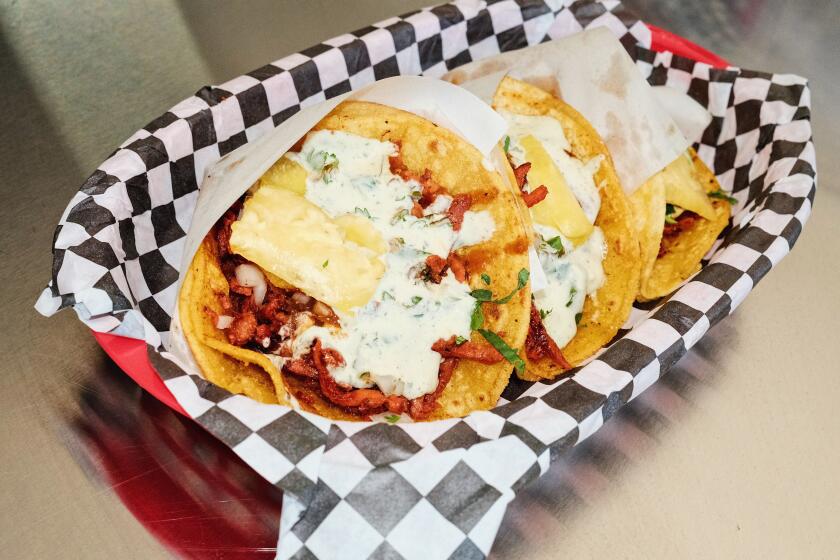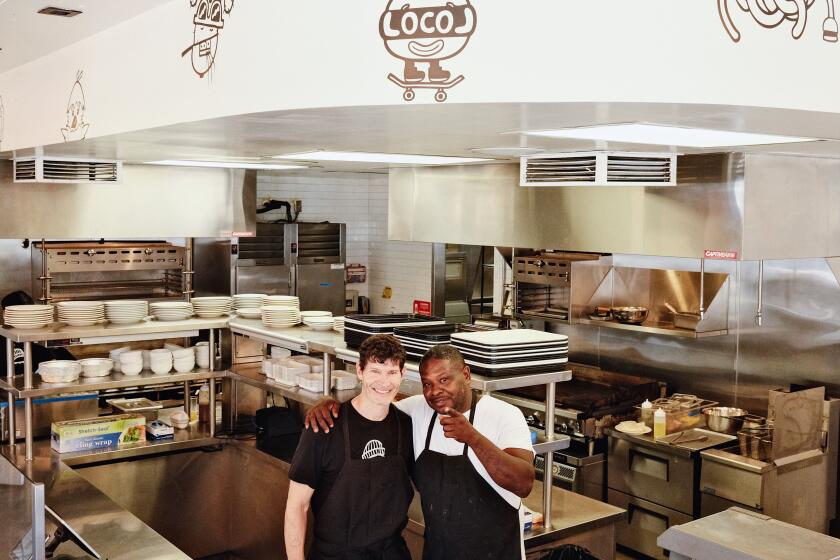Jim Dodge: American Baker
Pointing to the blueberry pie on the cover of his new book, “Baking With Jim Dodge--Simple and Tempting Delights from the American Baker” (Simon & Schuster, 1991: $25), the author admitted it would never have passed food photography standards in the 1970s. Some of the filling has slipped into the pie plate where a wedge has been removed, and the crust shows signs where the dark blue liquid bubbled through during baking.
“But if you cut into a fruit pie and nothing moves, it can’t be a good pie,” said Dodge. “The starch would overwhelm the flavor of the fruit and also make it unpalatable. A pie is a tribute to the quality of the fruit.”
To retain the fresh blueberry flavor, Dodge’s recipe uses less sugar and tapioca, which he believes is the best starch because its subtle flavor is more compatible with fruit. “It’s translucent and doesn’t make the filling cloudy,” added Dodge.
As for the crust, “it needs to have contrasting deposits of flavor. See how bubbly and flaky it is?” asked Dodge. “This provides a variance in flavor and makes it more interesting. The crust becomes the background for the filling.”
He’s a firm advocate of fresh ingredients and believes the only time to enjoy any fruit is when it’s at the peak of its season. Although trained by a European pastry chef, Dodge grew up in New Hampshire and prides himself on being an American baker.
“American desserts developed from the ground up--determined by the fruits, nuts and dairy products offered by the land itself,” says Dodge. His book is a collection of these simple recipes.
It would be a misnomer, however, to dismiss them as too easy. “The margin of error is greater in a simple recipe,” said Dodge. “Flaws are more apparent than in something that is highly decorated.”
In addition to the cobblers, cakes, brownies, turnovers, muffins and pancakes, he includes some European desserts that “we have adopted as our own. American desserts today, like the American people, include many that were born in Europe, and that is part of the strength of our baking tradition,” comments Dodge in the forward to his book.
Thus the cookie chapter includes madeleines, florentines and biscotti , which he describes as the “dry, hard, twice-baked Italian cookies that beg to be dunked in coffee, milk or (for a special treat) the sweet Italian wine called vin santo .”
Dodge demonstrated how to bake his recipe for Anise and Walnut Biscotti (flavored with orange and lemon zest) on a recent visit to The Times Test Kitchen. After beating the eggs and sugar, he added melted butter and the combined dry ingredients (Step 1), then blended them together.
Dividing the dough in half, Dodge began forming each portion into a log (Step 2). The finished rolls measured 14 inches in length (Step 3) and were placed on a baking sheet lined with parchment paper.
After pressing the tops of the logs to flatten them slightly, Dodge brushed each with a reserved egg white (Step 4) before baking in a 375-degree oven. Once the logs were light brown but the tops still gave slightly when pressed, Dodge removed the pan and reduced the oven temperature to 325 degrees.
While still warm, the logs were cut diagonally into one-half-inch slices (Step 5), then returned to the baking sheet, the slices placed on their sides and spread apart. They were baked again until brown.
Although the actual recipe leaves the cookies plain, Dodge adapted the technique from another of the book’s recipes, Chocolate and Hazelnut Biscotti, to demonstrate how to dip the cooled cookies.
He cut the chocolate into one-half-inch chunks and placed two-thirds in a stainless steel bowl, spreading it in an even layer over the bottom and up the sides of the bowl. Next he covered the bowl with plastic wrap and set it over the top of a saucepan in which water had been brought to simmering, then removed from the heat.
After allowing the chocolate to stand until it was about 80% melted, Dodge removed the bowl from the pan and wiped the sides and the bottom dry with a towel. He removed the plastic wrap and stirred the chocolate with a metal spoon until all of it was melted, then added the remaining one-third chocolate and continued stirring until it too had melted.
It’s important not to let the temperature of the chocolate drop below 88 degrees on a candy thermometer, explained Dodge. If it does, place the bowl back over the saucepan of warm water and continue stirring. The chocolate is ready for dipping when it is smooth and glossy.
Have a clean sheet of parchment paper nearby. Dip half of each cookie in the chocolate (Step 6), then as the cookie is removed, scrape the top and bottom against the side of the bowl to remove the excess chocolate. Set the cookies on the parchment until the chocolate sets.
ANISE AND WALNUT BISCOTTI
1 2/3 cups bread flour
2 cups cake flour
2 cups walnut pieces
1/2 teaspoon baking powder
1/4 teaspoon baking soda
1 tablespoon anise seeds
1/2 cup unsalted butter
3 eggs
1 1/3 cups sugar
2 teaspoons lemon zest
2 teaspoons orange zest
1/2 teaspoon anise extract
1/2 pound bittersweet or semisweet chocolate, optional
Blend bread and cake flours, walnuts, baking powder, baking soda and anise seeds in bowl. Melt butter and set aside to cool.
Beat 2 eggs, 1 additional egg yolk and sugar until smooth. Reserve remaining egg white. Stir in zests and anise. Add butter and mix until smooth. Add dry ingredients and mix to smooth dough.
Roll dough into 2 (14-inch) logs and place on baking sheet lined with parchment paper. Press tops of logs to flatten slightly. Brush with reserved egg white.
Bake at 375 degrees until logs are light brown, but still give slightly when tops are pressed, about 30 minutes. Remove pan from oven and reduce temperature to 325 degrees.
While logs are still warm, cut diagonally into 1/2-inch slices. Return slices to baking sheet, placing on sides and spreading apart. Return to oven and bake until cookies are brown, about 15 minutes. Remove from oven and cool on wire racks.
Cut chocolate into 1/2-inch chunks. Place 2/3 in stainless steel bowl, spreading in even layer over bottom and up sides of bowl. Cover bowl with plastic wrap.
Fill medium saucepan 1/3 full of water. Bring water to simmer over high heat. Remove pan from heat and set bowl of chocolate over top. Let stand until about 80% of chocolate has melted.
Remove bowl from pan and wipe sides and bottom dry with towel. Remove plastic wrap and stir chocolate with metal spoon until all is melted. Add remaining 1/3 chocolate and continue stirring until melted.
Do not let temperature of chocolate drop below 88 degrees on candy thermometer. If so, place bowl over saucepan of warm water and continue stirring. Stir until chocolate is smooth and glossy.
Have clean sheet of parchment paper nearby. Dip 1/2 of each cookie in chocolate. As cookie is removed, scrape top and bottom against side of bowl to remove excess chocolate. Set cookies on parchment until chocolate sets, about 3 hours.
Store biscotti in airtight container up to 1 week. Makes about 4 dozen cookies.
More to Read
Eat your way across L.A.
Get our weekly Tasting Notes newsletter for reviews, news and more.
You may occasionally receive promotional content from the Los Angeles Times.






